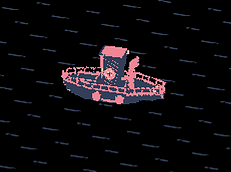ARAVIND SUNDARARAJAN
Drink - Sailing Racing Game
A sailing racing game featuring sprite-stacking 3D rendering and procedurally generated audio
Game Overview
Drink is a sailing racing game that combines classic racing mechanics with innovative technical approaches to 3D rendering and audio design. The game features a unique sprite-stacking technique for 3D visuals and procedurally generated sound effects created from synthesized white noise.
Developed as a submission to The Indie Tales Jam, this project demonstrates the ability to create engaging racing gameplay while experimenting with unconventional rendering and audio techniques. The game showcases creative problem-solving in game development, using sprite-stacking to achieve 3D-like visuals without traditional 3D engines.
The game features a consistent island environment where different racing stages use the same map but with varying checkpoint locations, similar to Mario Kart's standard tracks versus mirror mode. This design choice creates familiar yet varied racing experiences while maintaining the game's charming aesthetic.
Gameplay

Controls
- A/D Keys - Steer the boat left and right
- W/S Keys - Control speed (accelerate/brake)
- Q/E Keys - Additional control options
- Right Mouse Button - Special action
Gameplay Features
- Sailing Mechanics - Realistic boat steering and speed control
- Racing Stages - Multiple tracks using the same island with different checkpoint layouts
- Checkpoint System - Navigate through strategic waypoints
- Procedural Audio - Dynamic sound effects generated from white noise
- Sprite-Stacking 3D - Innovative rendering technique for depth perception
Key Features
Racing Mechanics
- Sailing boat controls and physics
- Multiple racing stages and tracks
- Checkpoint-based navigation system
- Speed and steering management
- Consistent island environment
Technical Features
- Sprite-stacking 3D rendering
- Procedurally generated audio
- White noise synthesis for effects
- GameMaker Studio 2 implementation
- HTML5 and Windows deployment
Development Process
The Indie Tales Jam Experience
Drink was developed as a submission to The Indie Tales Jam, a game development event that challenges creators to tell stories through interactive experiences. The jam provided an opportunity to experiment with unconventional game development techniques while creating an engaging racing experience.
The development process involved:
- Sprite-Stacking Implementation: Creating 3D-like visuals using layered 2D sprites
- Audio Synthesis: Generating sound effects from white noise using triple oscillators
- Racing System Design: Implementing boat physics and checkpoint mechanics
- Visual Design: Creating pixel art assets using Aseprite and MagicaVoxel
- Cross-Platform Development: Deploying to both HTML5 and Windows platforms
Technical Implementation
Game Engine: GameMaker Studio 2
Art Tools: Aseprite, MagicaVoxel
Audio Tools: LMMS, Audacity
Rendering: Sprite-Stacking Technique
Platforms: HTML5, Windows
Genre: Racing, SailingInnovative Techniques
- Sprite-Stacking Rendering: Implemented a technique where multiple 2D sprites are layered to create the illusion of 3D depth without traditional 3D engines
- Procedural Audio Generation: Created ocean waves and explosion effects by synthesizing white noise using triple oscillators and applying various audio effects
- Modular Track Design: Built a system where the same island environment serves multiple racing stages with different checkpoint configurations
- Cross-Platform Optimization: Ensured consistent performance across web and desktop platforms
- Custom Asset Pipeline: Integrated multiple tools (Aseprite, MagicaVoxel) for comprehensive asset creation
Art and Audio Design
- Pixel Art Creation: Designed all visual assets using Aseprite for consistent retro aesthetic
- 3D Asset Modeling: Used MagicaVoxel for creating voxel-based 3D elements
- Audio Synthesis: Generated custom sound effects using LMMS digital audio workstation
- Audio Processing: Applied effects and processing using Audacity for final sound design
- Visual Effects: Created dynamic ocean waves and explosion effects using sprite-stacking
Development Challenges
During development, several technical challenges were encountered and overcome:
Sprite-Stacking Implementation
Creating convincing 3D-like visuals using only 2D sprites required careful planning of sprite layers and depth perception. The technique needed to be optimized for performance while maintaining visual quality.
Audio Synthesis
Generating realistic ocean waves and explosion effects from white noise required experimentation with oscillator settings and audio processing techniques to achieve the desired sound quality.
Cross-Platform Compatibility
Ensuring the game performed consistently across HTML5 web browsers and Windows desktop required careful optimization and testing of the sprite-stacking technique on different platforms.
Player Reception
Drink has received positive feedback from the gaming community, with players particularly appreciating:
- Beautiful Art Design: The pixel art aesthetic and sprite-stacking technique create visually appealing graphics
- Innovative Rendering: The sprite-stacking approach provides an interesting alternative to traditional 3D rendering
- Engaging Gameplay: The sailing mechanics and racing elements provide enjoyable gameplay experiences
- Creative Audio Design: The procedurally generated sound effects add unique atmosphere to the game
- Technical Innovation: The combination of unconventional rendering and audio techniques showcases creative problem-solving
The game successfully demonstrates how experimental techniques can be used to create engaging gameplay experiences while pushing the boundaries of what's possible with traditional game development tools.
Project Impact
Drink represents a successful exploration of unconventional game development techniques and showcases several important development skills:
- Innovative Rendering: Implementation of sprite-stacking for 3D-like visuals
- Audio Synthesis: Creation of procedurally generated sound effects
- Cross-Platform Development: Deployment across multiple platforms
- Asset Creation Pipeline: Integration of multiple tools for comprehensive development
- Game Jam Experience: Rapid development and experimentation under time constraints
This project demonstrates the ability to think creatively about technical limitations and find innovative solutions. The combination of sprite-stacking rendering, procedural audio generation, and traditional racing mechanics shows how experimental approaches can enhance rather than hinder gameplay experiences.